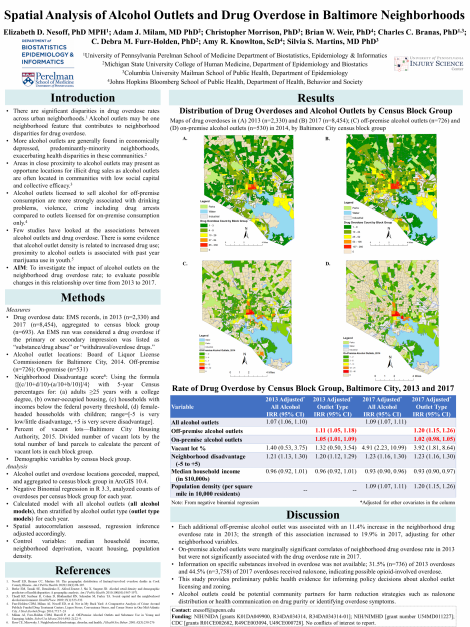Elizabeth Nesoff
Spatial analysis of alcohol outlets and drug overdose in Baltimore neighborhoods
Abstract
BACKGROUND: Alcohol outlets have been associated with various forms of injury and may contribute to neighborhood disparities in drug overdose. Few studies have examined the associations between alcohol outlets and drug overdose. This study investigated whether alcohol outlets were associated with the neighborhood drug overdose rate.
METHODS: A cross-sectional ecological spatial analysis was conducted within census block groups in Baltimore City (n=653). Outcomes were counts of EMS calls for any drug overdose in 2015 (n=3,856). Exposures of interest were counts of alcohol outlets licensed for off-premise and on-premise consumption. Negative binomial regression was used to assess the relationship between outlet count and overdose rate, controlling for other neighborhood factors. Spatial autocorrelation was assessed and regression inference adjusted accordingly.
RESULTS: Each additional off-premise alcohol outlet was associated with a 16.6% increase in the neighborhood overdose rate (IRR=1.17, 95%CI=(1.11, 1.23)), adjusted for other neighborhood variables. On-premise alcohol outlets were not significantly associated with overdose rate when adjusting for off-premise alcohol outlets (IRR=1.01, 95% CI=(0.97, 1.06)).
CONCLUSION: This study provides preliminary public health evidence for informing policy decisions about alcohol outlet licensing and zoning. Alcohol outlets could be potential community partners for harm reduction strategies such as health communication in identifying overdose symptoms or Good Samaritan Laws.
Keywords
drug overdose; alcohol outlets; neighborhoodsCommenting is now closed.
About Us
To understand health and disease today, we need new thinking and novel science —the kind we create when multiple disciplines work together from the ground up. That is why this department has put forward a bold vision in population-health science: a single academic home for biostatistics, epidemiology and informatics.
© 2023 Trustees of the University of Pennsylvania. All rights reserved.. | Disclaimer


